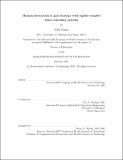Human interaction & gait strategy with tightly-coupled lower-extremity systems
Author(s)
Gupta, Aditi,M. Ph. D.Massachusetts Institute of Technology.
Download1251801873-MIT.pdf (11.81Mb)
Alternative title
Human interaction and gait strategy with tightly-coupled lower-extremity systems
Other Contributors
Harvard--MIT Program in Health Sciences and Technology.
Advisor
Leia A. Stirling.
Terms of use
Metadata
Show full item recordAbstract
Interest in the use of exoskeletons (wearable robotic devices tightly-coupled to the user's body) for human gait augmentation has soared recently, with research flourishing in system design, control, and use efficacy. Use cases span many fields, from military (e.g. load carriage assistance) to medicine (e.g. gait rehabilitation or restoration) and industry (e.g. injury prevention). Evaluating the human factors of human-exoskeleton interaction is an essential step towards operationalization. Unexplained variation in gait strategy and adaptation observed across individual operators must be better understood to enable safe and effective exoskeleton use in real-life environments. Cognitive fit is an individuals' understanding and ability to operate a system. Exoskeletons and similar tightly-coupled lower-extremity (TCLE) systems entail new interaction modalities that may affect cognitive fit. This thesis explores how cognitive factors and alternative interaction modalities impact individuals' gait and task performance. Two studies were conducted, one evaluating inhibitory control as measured by a modified Simon task using interaction modalities relevant to TCLE system use, i.e. tactile cues and lower-extremity responses. Second, the Human-Exoskeleton Strategy & Adaptation (HESA) study was implemented, in which individuals completed tasks assessing cognitive factors, i.e. inhibitory control and attention, then walked with an ankle exoskeleton. Evaluation of inhibitory control with tactile cues and lower-extremity responses resulted in slower response times and decreased response accuracy. A probe of attention in the HESA study, i.e. completion of a walking task on a self-paced treadmill, showed modified gait characteristics under increased attentional loads, particularly at slower walking speeds and with the addition of a secondary task. Individualized variation in exoskeleton gait, quantified by spatiotemporal gait characteristics, was explicitly presented for the first time, showing that distinct individuals initially prioritize goals like stability and coordination with an ankle exoskeleton differently. Finally, select measures of cognitive function were found to be correlated to individuals' exoskeleton gait strategy. Individual differences in baseline factors like inhibitory control and ability to perform tasks under divided attention impact individuals' cognitive fit with exoskeleton systems. This individualized variation, as well as broader population patterns, should inform exoskeleton design and training by encouraging gait strategies that support desired exoskeleton use goals. For example, stroke patients using an exoskeleton to restore their gait and mitigate fall risk should prioritize stability during system use, while factory workers should prioritize system coordination to minimize injury risk. This thesis provides foundational insights into human-exoskeleton interaction and gait strategy from a human factors perspective.
Description
Thesis: Ph. D., Harvard-MIT Program in Health Sciences and Technology, February, 2021 Cataloged from the official PDF version of thesis. Includes bibliographical references (pages 133-148).
Date issued
2021Department
Harvard University--MIT Division of Health Sciences and TechnologyPublisher
Massachusetts Institute of Technology
Keywords
Harvard--MIT Program in Health Sciences and Technology.